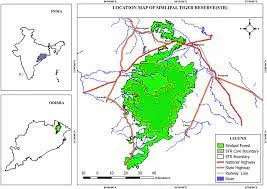Environment & Ecology
In News: Similipal National Park has turned out to be the hunting ground for animal poachers over the last few years.
- Most recently, the carcass of a male elephant was found in the Talabandha wildlife range
Simplipal National Park

- Located in northern part of Odisha’s Mayurbhanj district
- Similipal derives its name from ‘Simul’ (Silk Cotton) tree
- It is a national park and a Tiger Reserve
- The tiger reserve is spread over 2750 sq km and has some beautiful waterfalls like Joranda and Barehipani.
- The park is surrounded by high plateaus and hills, the highest peak being the twin peaks of Khairiburu and Meghashini (1515m above mean sea level).
- At least twelve rivers cut across the plain area, all of which drain into the Bay of Bengal – Burhabalanga, Palpala Bandan, Salandi, Kahairi and Deo.
- Prominent tribes – Kolha, Santhala, Bhumija, Bhatudi, Gondas, Khadia, Mankadia and Sahara.
- The vegetation is a mix of deciduous with some semi-evergreen forests
- Sal is the dominant tree species
Biodiversity in the park:
- An astounding 1078 species of plants including 94 species of orchids find their home in the park.
- These forests boast of many plants that have medicinal and aromatic properties.
- The park is known for the tiger, elephant and hill mynah.
- It holds the highest tiger population in the state of Odisha.
- Apart from the tiger, the major mammals are leopard, sambar, barking deer, gaur, jungle cat, wild boar, four-horned antelope, giant squirrel and common langur.
- Grey hornbill, Indian pied hornbill and Malabar pied hornbill are also found here.
- The park also has a sizeable population of reptiles, which includes the longest venomous snake, the King cobra and the Tricarinate hill turtle.
- The Mugger Management Programme at Ramatirtha has helped the mugger crocodile to flourish on the banks of the Khairi and Deo Rivers
- Similipal has turned out to be the haven for hunters and poachers as the region has witnessed several killings of elephants, tigers and leopards
Threats:
- About 20 adult breeding male elephants die each year, mostly to unnatural causes like poaching and electrocution.
- The dwindling breeding male population and the isolated populations due to fragmented forests is weakening the gene pool due to mating among immature individuals and inbreeding.
- There is a link between poaching and trading of elephant tusks, tiger skins and leopard skins since these fetch a huge price in the international market despite the global ban
- Even though Elephants are protected under Schedule 1 of the Wildlife Protection Act, 1972, there is a rise in poaching cases
- While tiger population has gone up in most Indian states, in Odisha it has come down or remained static
Source: DTE
Previous Year Question
Q1) With reference to India’s Desert National Park, which of the following statements are correct? (2020)
- It is spread over two districts.
- There is no human habitation inside the Park.
- It is one of the natural habitats of Great Indian Bustard.
Select the correct answer using the code given below:
- 1 and 2 only
- 2 and 3 only
- 1 and 3 only
- 1, 2 and 3














